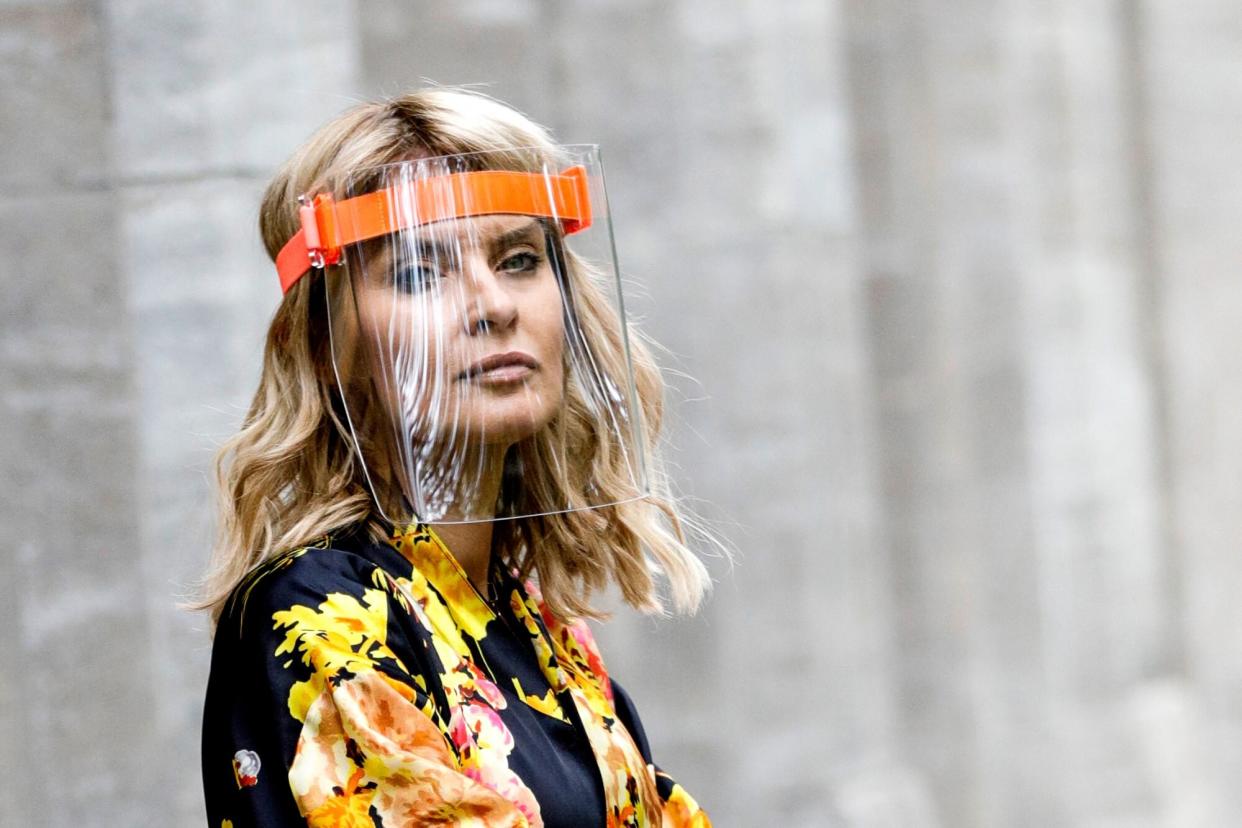Do Plastic Face Shields Actually Do Anything?

Streetstyleograph/Getty Images
Early on in the pandemic, you probably saw plastic face shields in images of hospital workers. But, just like face masks, they quickly became more commonplace. Influencers started wearing them in street style photos and some people even started wearing them on their weekly trips to the grocery store. And as many noted, since they allow us to see facial expressions, they were crucial for allowing the hearing impaired to read lips.
But now, months later, we finally have some real information on how much protection plastic face shields (sometimes referred to as "COVID visors") actually provide. Here's what you need to know.
Do plastic face shields protect from the coronavirus?
Quick recap: the new coronavirus and COVID-19, the illness it causes, are primarily spread through respiratory droplets, which come out of your mouth and nose when you breathe, talk, sneeze, sing, and so on. So the main goal of wearing a surgical mask, or a mask with a filter, is to prevent those droplets from getting into your mouth and nose. (Cloth face masks and coverings work by preventing people from spreading respiratory droplets to others.) Masks and face coverings also have the benefit of reminding people not to touch their faces — which is another way the virus can spread.
But you may be able to get COVID-19 through your eyes, as well. "Theoretically, the virus of COVID-19 could arrive to the eyes and travel down through our tear ducts into the nose and throat," explains Stephen Berger, M.D., a double board-certified infectious disease specialist and microbiologist, and founder of GIDEON, the Global Infectious Disease and Epidemiology Online Network. This route of infection hasn't been proven but is suspected to be how some people get the virus, which is why Dr. Fauci recommended adding goggles to your lineup of protective gear.
RELATED: Dr. Fauci Now Says We Should Be Wearing Goggles — Here's What You Need to Know
"A recent research analysis shows face shields might protect you from catching COVID-19 through your eyes," explains Arefa Cassoobhoy, M.D., MPH, Senior Medical Director at WebMD. "Also, there's evidence from research with the flu virus that face shields may partially block breathing in droplets of the virus, especially when it's combined with keeping a six-foot physical distance from others." Though the flu virus and the coronavirus are different, this research shows face shields may help prevent some spread through respiratory droplets in general.
But because there's so much uncertainty about the coronavirus in general, not all experts are convinced face shields are a good idea. "Plastic visors and shields do not filter air, and at most, prevent larger droplets of infectious material from arriving to our face directly," Dr. Berger explains.
What's more, Dr. Berger says the user might have a false sense of security while wearing a face shield and abandon other rules of social distancing. He also emphasizes that in order to be fully protected while wearing a shield, the wearer needs to also wear a face mask that filters air, as well.
This has now been confirmed with research that shows plastic face shields without a face mask underneath are largely ineffective at preventing the spread of COVID-19. The study out of Japan found that almost 100% of airborne droplets of less than 5 micrometers in size escaped through plastic visors, the Guardian reported. For this reason, experts are strongly recommending that you stick to your regular cloth face mask, instead of swapping it out for a plastic face shield.
RELATED: Wearing Gloves to Protect Yourself from COVID-19 May Do More Harm Than Good
OK, so are there any benefits of plastic face shields?
While they aren't recommended on their own, there are a few times when a plastic face shield may be helpful: "It's reasonable to add a face shield if you want an extra layer of protection, especially if you're in a high-risk situation, like caring for someone sick with COVID-19 or working in an environment that requires close contact with others," Dr. Cassoobhoy says.
Another time a shield might be helpful? "If you're exercising outside and aren't comfortable wearing a face mask, a face shield could be an option to add some level of protection."
RELATED: The 15 Best Workout Apps to Download Now
There are a few other reasons face shields may become the new norm, according to Debbie Goff, PharmD, Infectious Disease Specialist and Professor of Pharmacy at The Ohio State University Wexner Medical Center. First, it's really hard to touch your face while wearing one of these things. "They are also eco-friendly, since they can be cleaned and reused," Goff says.
How to wear a plastic face shield the right way:
If you decide to add face shields to your personal protective routine, there are a few things to keep in mind.
"The face shield's clear plastic should extend across your face to both ears, and down well below the chin," Dr. Cassoobhoy says. "There should not be any gap between your forehead and the headpiece. There are many varieties available, choose one that is comfortable, reusable, and easy to clean with soap and water."
And when you remove it, be sure not to touch the front of the plastic shield, Goff advises. "Just touch the back of the strap around the forehead." Once you've taken it off, wash the shield with soap and water, set aside, then wash your hands.
Bottom line? "To prevent the spread of COVID-19, you should continue physical distancing measures including wearing a cloth face mask, keeping a minimum of six-feet distance from others outside the home, avoiding large gatherings, and practicing good hand hygiene," says Dr. Cassoobhoy.
The coronavirus pandemic is unfolding in real time, and guidelines change by the minute. We promise to give you the latest information at time of publishing, but please refer to the CDC and WHO for updates.

